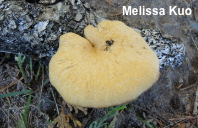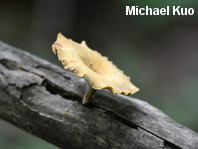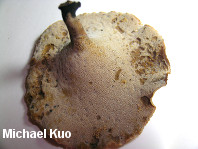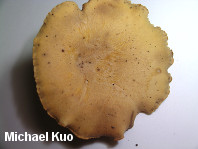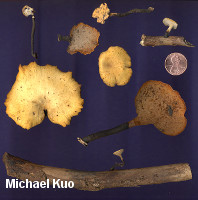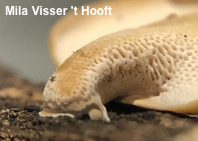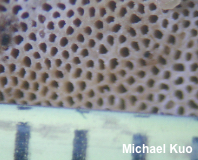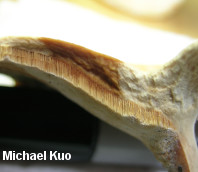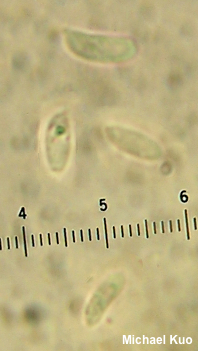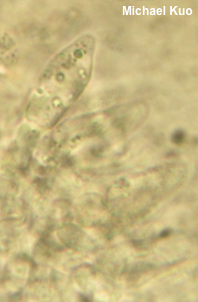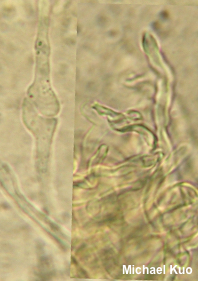| Major Groups > Polypores > Stemmed, Pale-Fleshed > Polyporus varius |

|
Polyporus varius [ Basidiomycota > Polyporales > Polyporaceae > Polyporus . . . ] by Michael Kuo Typically fruiting on smaller hardwood sticks and decaying branches, this polypore is fairly easily recognized by its small size, its pale pore surface, and its black, or half-black, more or less central stem. The black covering on the stem is absent in young specimens, and then appears at the base of the stem, moving upwards with maturity. Polyporus varius is widely distributed across North America, and is somewhat variable in the color and texture of its cap. Like many polypores it is rather tough, and can manage to "stay up" for quite a while in dry weather—resulting in older specimens with faded, nearly white caps and sordid brownish pore surfaces. Polyporus badius is vaguely similar but is larger, redder, and proportionally shorter-stemmed. Polyporus melanopus is even more similar in appearance, but not in habitat; it grows terrestrially. Polyporus elegans, Polyporus leptocephalus, and Cerioporus varius are among many synonyms for this species. Thanks to Mila Visser 't Hooft for documenting, collecting, and preserving Polyporus varius for study; her collection is deposited in The Herbarium of Michael Kuo. Description: Ecology: Saprobic on decaying hardwood sticks and small logs that have lost their bark; causing a white rot; growing alone or scattered; first appearing in late spring and early summer, but often collected in summer and fall; widely distributed in North America; also known from South America, Europe, Asia, and Australasia. The illustrated and described collections are from California, Colorado, Illinois, Kentucky, Michigan, and North Carolina. Cap: 2–7 cm; planoconvex to flat, developing a central depression and an uplifted margin; usually round in outline, but sometimes cleft or somewhat kidney-shaped; dry; bald or very finely radially appressed-fibrillose; dull yellow to pale tan. Pore Surface: Running down the stem; whitish to pale grayish when young, becoming dingy brownish in age; sometimes bruising faintly brownish; with 3–5 angular pores per mm at maturity; tubes 1–3 mm deep. Stem: Central or off-center to lateral; 1–3 cm long; 2–7 mm wide; tapered slightly to base; often curving; dry; bald and pale tan at the apex, becoming finely velvety and dark brown to black from the base upward; tough. Flesh: Whitish to dingy yellowish; unchanging when sliced; thin; very tough. Odor and Taste: Odor usually fragrant; taste not distinctive. Chemical Reactions: KOH brownish orange on flesh and cap surface. Spore Print: White. Microscopic Features: Spores 6–10 x 2–3 µm; cylindric; smooth; hyaline in KOH; inamyloid. Basidia 4-spored. Setae not found. Cystidioles 20–27 x 4–9 µm; lageniform; smooth; thin-walled; hyaline in KOH. Hyphal system dimitic. Generative hyphae 3–6 µm wide, thin-walled, smooth, hyaline in KOH, clamped at septa. Skeletal hyphae 2–5 µm wide, thick-walled, nonseptate, branching, smooth, hyaline to brownish in KOH. REFERENCES: (Persoon, 1796) Fries, 1821. (Overholts, 1953; Smith, Smith & Weber, 1981; Arora, 1986; Breitenbach & Kränzlin, 1986; Gilbertson & Ryvarden, 1987; Phillips, 1991/2005; Lincoff, 1992; Nunez & Ryvarden, 1995; Horn, Kay & Abel, 1993; Barron, 1999; Kruger et al., 2006; McNeil, 2006; Sotome et al., 2008; Kuo & Methven, 2014; Desjardin, Wood & Stevens, 2015; Woehrel & Light, 2017; Elliott & Stephenson, 2018; Sturgeon, 2018; Læssøe & Petersen, 2019.) Herb. Kuo 05110307, 06140801, 06291406, 06141501, 06071601, 06061802, 01122002. Herb. DBG RMNP 2008-005, 2008-114, 2009-070, ROMO 2012 5025-27, ROMO 2012 5027-05, ROMO 5027-29, ROMO 2012 5027-34. This site contains no information about the edibility or toxicity of mushrooms. |
© MushroomExpert.Com |
|
Cite this page as: Kuo, M. (2020, February). Polyporus varius. Retrieved from the MushroomExpert.Com Web site: http://www.mushroomexpert.com/polyporus_varius.html |
